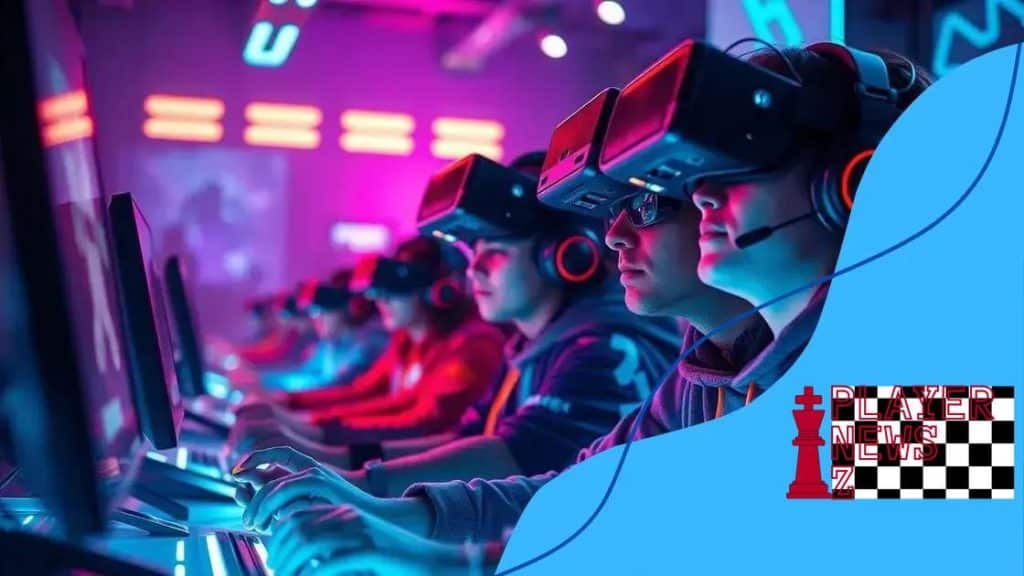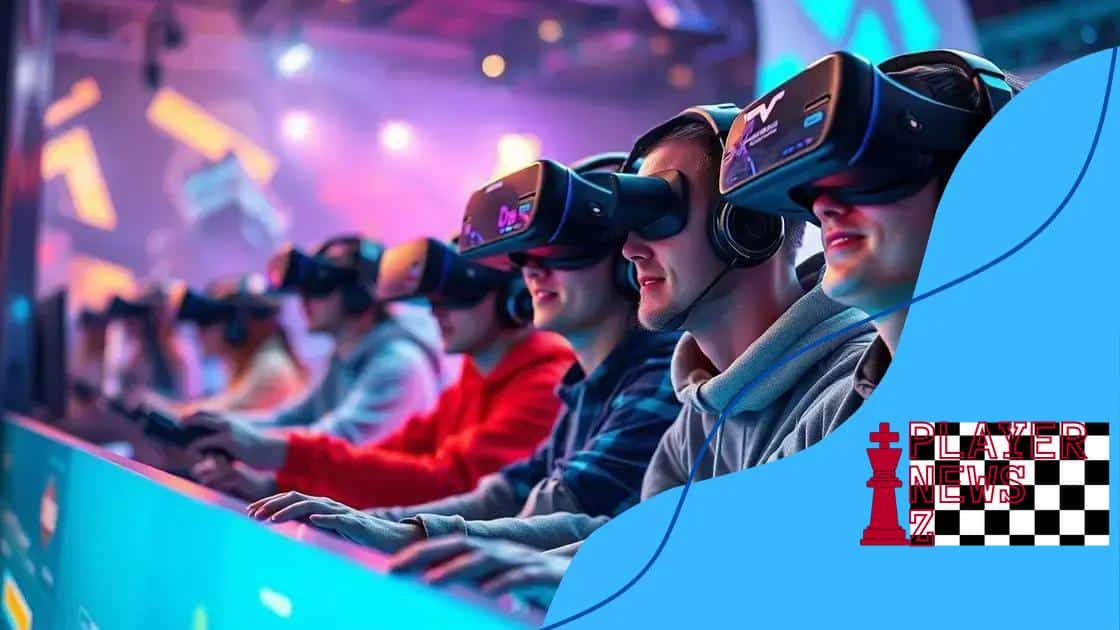The future of VR e-sports: are you ready to compete?

The future of VR e-sports includes enhanced immersive gameplay, AI integration for unique challenges, and expanded accessibility, promising a vibrant and engaging experience for players.
The future of VR e-sports is shaping up to be an exhilarating frontier for gamers. Have you ever imagined diving into a fully immersive gaming environment? This article explores how VR is transforming the e-sports arena.
The rise of virtual reality in gaming
The rise of virtual reality in gaming has changed how people interact with digital environments. Gamers now have the chance to step inside their favorite worlds and experience them like never before.
What is virtual reality?
Simply put, virtual reality (VR) creates a lifelike experience using technology. Through VR headsets and other gear, players can feel as if they are actually present in the game, which makes it more immersive. This technology captures their movements and brings them to life in a digital space.
Benefits of VR in gaming
- Enhanced immersion: Players can feel part of the action.
- Realistic experiences: Games can simulate real-world physics.
- Social interaction: Players can engage with friends in a virtual environment.
- Therapeutic uses: VR can help people overcome fears or simulate experiences safely.
The future of VR gaming shows potential for more innovative experiences. Developers are continuously finding ways to improve gameplay and visual quality. As hardware becomes more affordable, more people can enjoy these experiences. Imagine playing a game where you can physically swing a sword or shoot arrows; it’s already happening!
With advancements in technology, such as the development of haptic feedback, players will have even more ways to engage with games. This technology allows users to feel sensations, creating a more realistic and interactive environment. The result is a gaming world that can be more engaging than traditional setups.
Key technologies shaping VR e-sports
Understanding the key technologies shaping VR e-sports is essential for anyone looking to dive into this exciting world. These technologies are revolutionizing how games are played and experienced.
Head-Mounted Displays
One of the most critical components of VR technology is the head-mounted display (HMD). This device allows players to see a fully immersive environment. With advancements in visual quality and field of view, these displays enhance the gaming experience significantly.
Motion Tracking
Another essential technology in VR e-sports is motion tracking. This technology uses sensors to track player movements in real-time. Gamers can move freely, and their actions reflect accurately in the game. This capability makes gameplay feel more natural and engaging.
Controllers and Haptic Feedback
- Haptic controllers: These devices provide tactile feedback, allowing players to feel the game environment.
- Gesture recognition: Players can interact with games using hand gestures, increasing immersion.
- Adaptive triggers: Some controllers offer varying resistance based on the in-game actions, enhancing realism.
As technology progresses, the integration of artificial intelligence and more sophisticated analytics will improve gameplay strategies. AI can help adapt challenges based on player skill, making every game unique. This innovation not only elevates the competitive aspect but also keeps players engaged longer, as each session can provide new experiences based on their previous performances.
Moreover, the continuous advancement in internet connectivity significantly impacts online VR e-sports. With faster internet speeds, players can compete in real-time without lag, giving a smoother experience. Low-latency connections allow for seamless interaction in virtual arenas and ensure that players can execute strategies effectively.
Popular VR e-sports games to know

When exploring popular VR e-sports games, it’s exciting to see how they blend competition and immersive gameplay. These games create dynamic environments where players can compete in thrilling matches while experiencing the virtual worlds around them.
Selection of Popular VR Games
Among the most renowned titles in VR e-sports, a few stand out due to their engaging gameplay and community presence. Games like ‘Beat Saber,’ ‘Echo Arena,’ and ‘Pavlov VR’ offer unique experiences that challenge players both physically and mentally.
- Beat Saber: A rhythm-based game that combines lightsaber mechanics with music, making it fun and highly competitive.
- Echo Arena: A zero-gravity sport that demands teamwork and strategy, as players navigate through a free-floating arena.
- Pavlov VR: A multiplayer first-person shooter that provides realistic gameplay with a community-driven environment for mods.
These VR e-sports games not only offer competitive play but also have vibrant communities that encourage player interaction and camaraderie. Social features within these games help players connect, share strategies, and form teams. Games with community forums and participation often create a more engaging experience. As players dive deeper into these expansive virtual worlds, they often find friendships and rivalries that add to the excitement.
As technology evolves, new games are emerging, enhancing the VR gaming landscape. These upcoming titles promise to push the boundaries of technology and creativity, allowing gamers to explore new genres and gameplay styles within the VR e-sports realm. No matter the genre, the goal remains the same: to provide players with an exhilarating experience unlike anything found in traditional gaming.
The impact of VR on competitive gaming
The impact of VR on competitive gaming is profound. As technology advances, players are embracing new methods of gameplay that enhance their experiences.
Immersive Gameplay
One of the most significant effects of VR is the level of immersion it provides. Players can feel like they are truly part of the game, moving within a 3D environment. This deep sense of presence not only makes games more enjoyable but also challenges gamers to adapt their skills to a new playing field.
Strategic Gameplay Changes
This immersion changes how players think about competition. Strategies must evolve in a virtual arena where traditional gaming skills may not apply. Players are now required to develop skills related to spatial awareness and real-world movements to excel in the VR gaming landscape.
New Competitive Formats
- Team-based play: Many VR games focus on teamwork. Success often depends on how well players communicate and coordinate actions.
- Individual skill showcases: Players can demonstrate their abilities in new, exciting ways that highlight their personal skills.
- Dynamic environments: VR games often offer changing environments that require quick thinking and adaptation.
In addition to skill sets, the competitive atmosphere surrounding VR e-sports has shifted. Events are becoming more exciting, attracting a variety of players and spectators. A virtual reality tournament can recreate the thrill of a live event without the geographical barriers, allowing fans to participate globally. As a result, developers are focusing on creating games that not only capture attention but also are built for competition.
Furthermore, the integration of social features within these games allows players to build communities around shared interests. Gamers can meet, engage, and form friendships in virtual worlds, enhancing the overall experience and creating a dedicated fan base for competitive gaming.
Future trends in VR e-sports
The future trends in VR e-sports are poised to revolutionize the gaming landscape even further. As technology progresses, gamers can expect more advanced and engaging experiences.
Enhanced Reality Features
One of the key trends is the integration of enhanced reality features. These advancements will allow players to interact with both the virtual world and elements of the real world simultaneously. Imagine a game where you can blend real-life movements with virtual challenges, creating a richer gaming experience.
Artificial Intelligence Integration
Another significant trend is the use of artificial intelligence (AI) to create smarter opponents and dynamic game environments. AI can analyze player behavior and adapt to their strategies, ensuring every match feels unique. This could lead to more intense and competitive gameplay as players constantly face new challenges.
Expanded Platforms and Accessibility
- Cross-platform gameplay: Future VR games may allow players on different devices to compete against each other, increasing the community.
- Affordable VR technology: As production costs decrease, more players will gain access to VR gaming, expanding the player base.
- Cloud gaming: Streaming technology is set to make high-quality VR games accessible without the need for expensive hardware.
The social aspect of VR e-sports will also grow. Players will have more opportunities to join communities, participate in events, and engage with each other. The rise of competitive leagues and tournaments is expected, drawing in larger audiences and creating more significant sponsorship opportunities for players and teams.
Finally, as developers innovate, we can expect a surge in new genres and gameplay styles within VR. These new games may offer different perspectives and unique challenges, keeping the gaming landscape fresh and exciting. This will not only attract seasoned players but also new gamers eager to explore these evolving virtual worlds.
VR e-sports is evolving rapidly, bringing exciting changes for players and fans alike. With advancements in technology, games become more immersive and competitive. As we look to the future, trends like enhanced reality, AI integration, and affordable access will shape new experiences. This evolution not only attracts seasoned gamers but also opens the door for newcomers. As communities grow and new genres emerge, the future of VR gaming promises to be bright and full of opportunities for everyone to enjoy.
FAQ – Frequently Asked Questions about VR e-sports
What are the benefits of VR in e-sports?
VR enhances immersion and gameplay, allowing players to feel like they are part of the action, which makes for a more exciting gaming experience.
How is AI used in VR e-sports?
AI is used to create smarter opponents and adjust gameplay based on player behavior, ensuring that each match presents unique challenges.
Will VR games be more accessible in the future?
Yes, as technology advances and production costs decrease, more players will have access to VR gaming, allowing for a larger player community.
What trends should we expect in VR e-sports?
Future trends include enhanced reality features, community growth, and a variety of new gaming genres that will keep the experience fresh and engaging.





